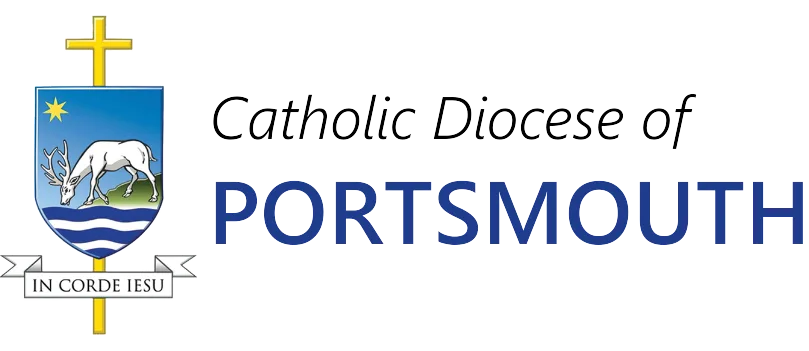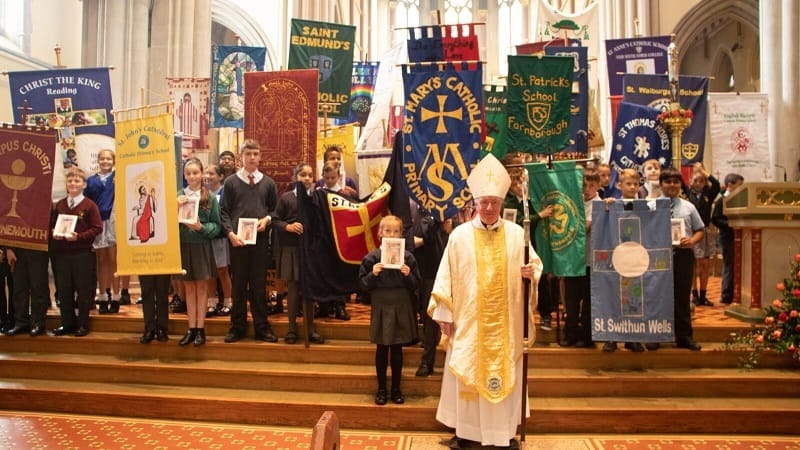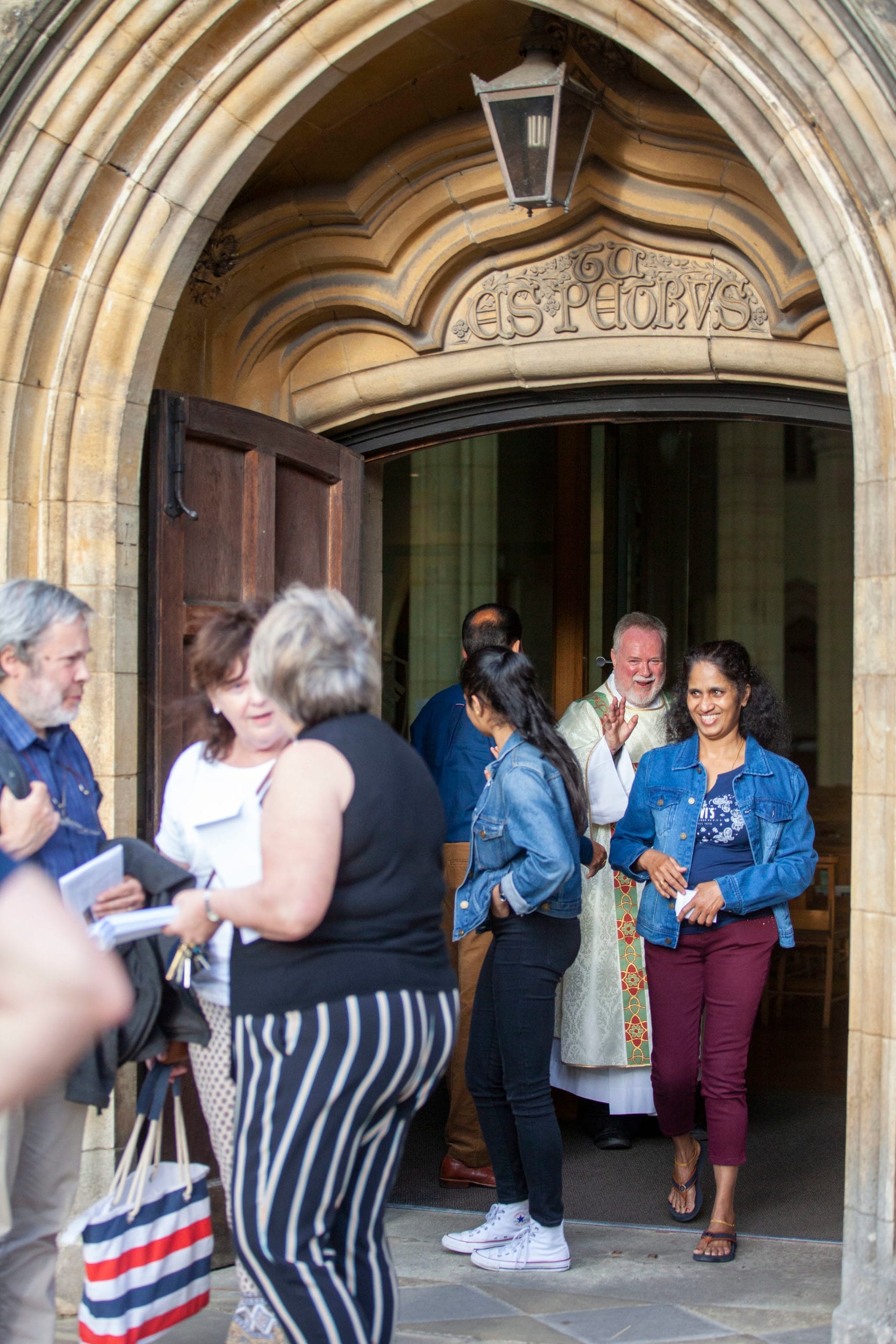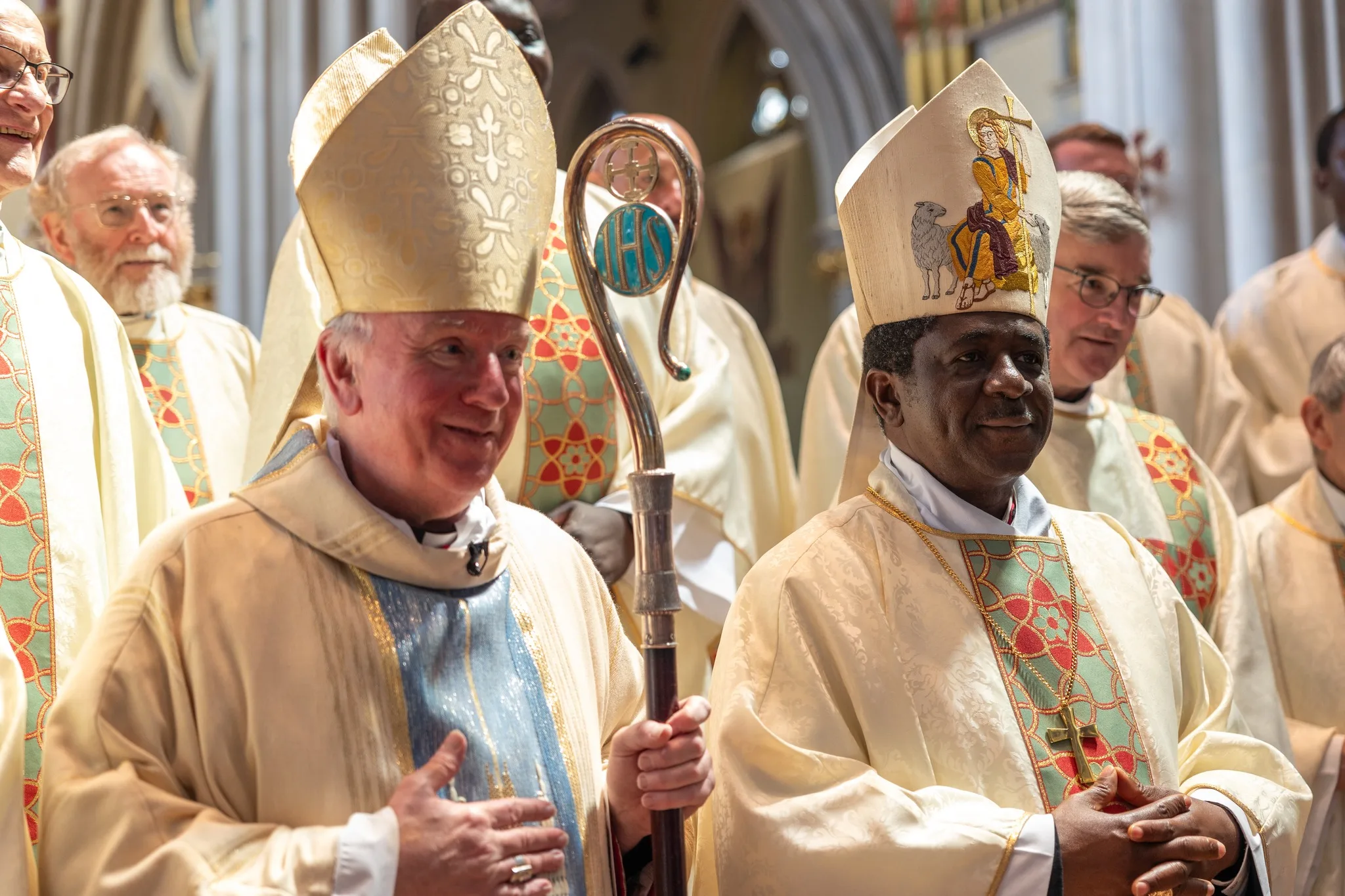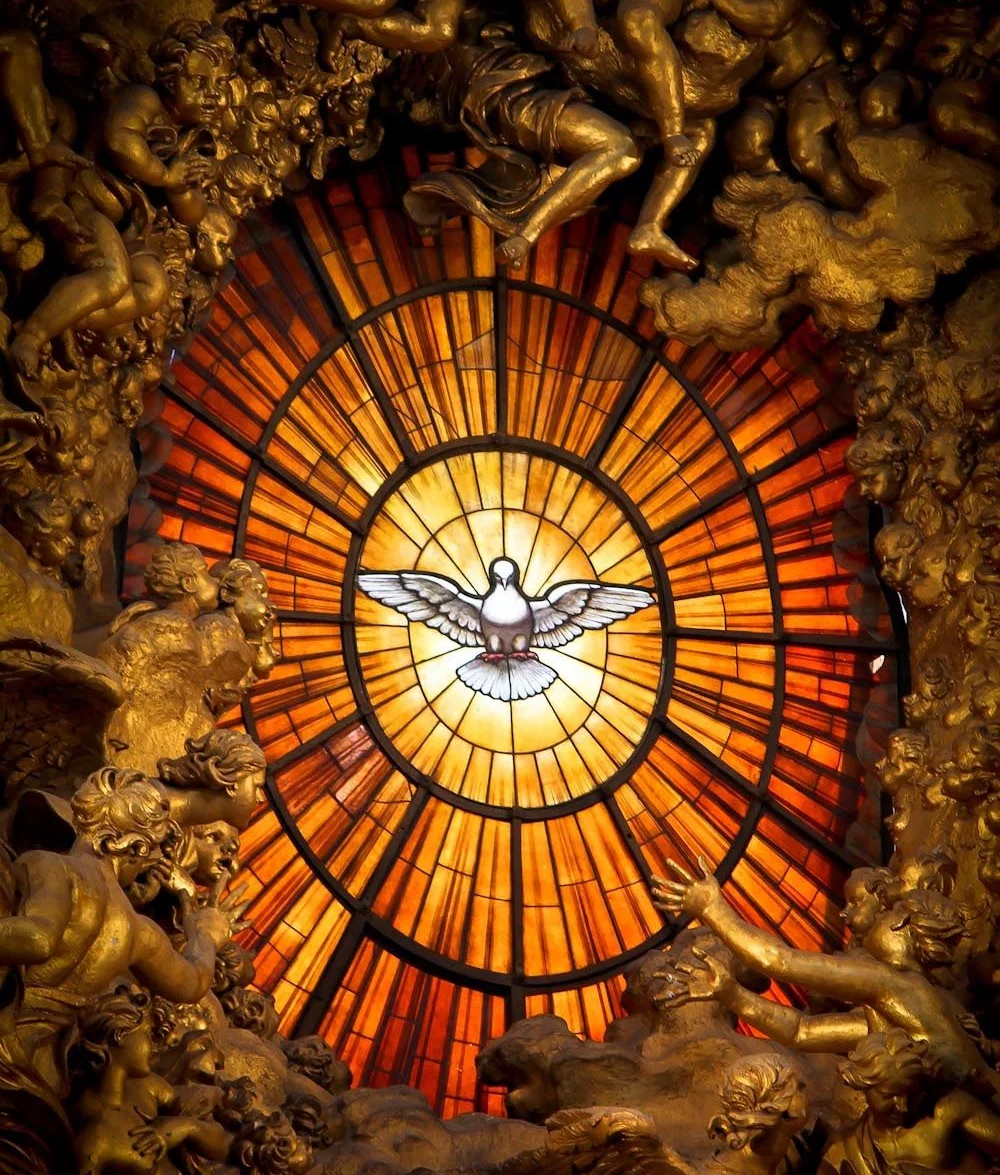
We are the Diocese of Portsmouth, governed by the Bishop of Portsmouth, Bishop Philip Egan. We belong to the One, Holy, Catholic Church, which is led by the Bishop of Rome, Pope Leo XIV.
Our Diocese is spread across five counties on England’s South Coast, and the Channel Islands. We are the local Church for the whole of Hampshire, Berkshire, the Isle of Wight, Jersey, and the Bailiwick of Guernsey as well as the Southern Part of Oxfordshire and the Eastern part of Dorset.
We belong to the province of Southwark, which covers the whole south coast from Kent to Cornwall. Our Metropolitan is the Archbishop of Southwark. Our province also includes the Archdiocese of Southwark, the Diocese of Arundel and Brighton, and the Diocese of Plymouth.
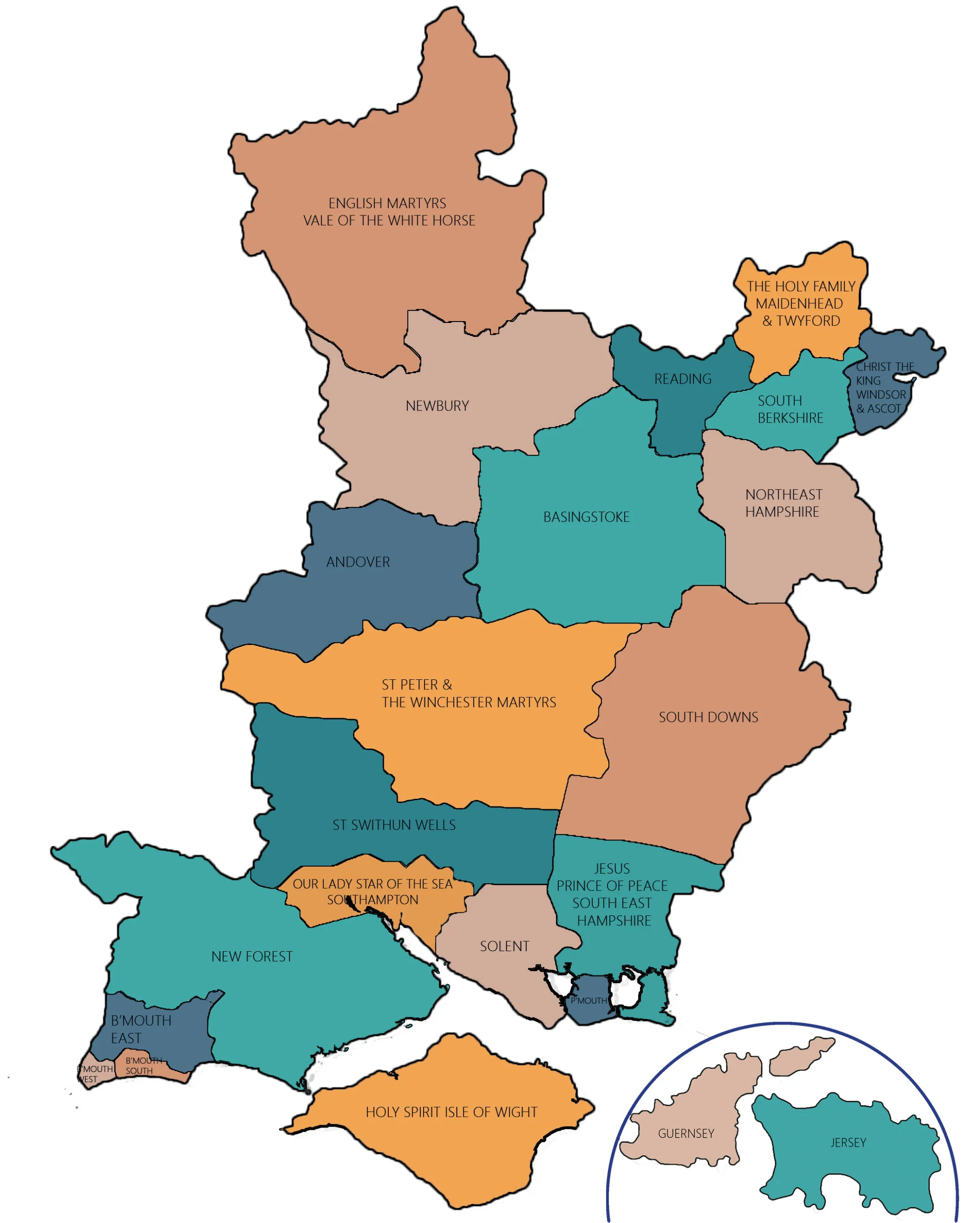
Our history
1558-1850: Persecution and Emancipation
From the late 1580s a series of harsh anti-Catholic laws were passed in England to ensure the supremacy of the Church of England. For the next two centuries, Catholics in England, Ireland, Scotland, and Wales would be persecuted, arrested, and executed for treason for the crime of holding to the Catholic Faith and obedience to the Pope in Rome.
In England, the systematic persecution of Catholics led to the martyrdom of many hundreds of faithful Catholics, both male and female and belonging to every social class. Our own diocese has several Canonised and Beatified martyrs from this time.
1850 - 1882: The Diocese of Southwark
The area covered by our Diocese was originally part of the London District, and was assigned to the new Diocese of Southwark. The First Bishop of Southwark was Thomas Grant.
The Pope’s actions were highly controversial in England, and was described by the Prime Minister, John Russell, as an act of “Papal Aggression.” A new law was passed in 1851 banning Catholic Bishops from claiming any territorial jurisdiction. This law was obeyed by the Bishops but ignored by ordinary Catholics. Nobody was ever prosecuted and the law was repealed in 1871.
There were numerous publications against the Catholic Church at this time, and on Guy Fawkes Night there were incidents of Church windows being smashed, and Cardinal Wiseman was burned in effigy alongside effigies of the Pope and the other twelve new Bishops.
1880: A New Diocese in Need of A Home
It soon became apparent that the Diocese of Southwark, stretching from London to Bournemouth and encompassing the Channel Islands and the South of Oxfordshire, was too large for just one Bishop. A decision was made to create a new diocese from the Western half of Southwark. This diocese would be made up of Hampshire, South Oxfordshire, Berkshire, and the Channel Islands.
The new Diocese was almost coterminous with the ancient (now Anglican) Diocese of Winchester. Since the law forbade another Diocese of Winchester from being founded, it seems that the original intention was to place the new Cathedral in Southampton. The Church of St Joseph, on Southampton’s Bugle Street (pictured) was designated as the Pro Cathedral. It was, however, made too difficult to find a suitable plot of land for the new Cathedral in Southampton. The decision was made to found the Diocese in Portsmouth, where a large new Church was being built.
1882: The Diocese of Portsmouth
On 19 May 1882, Pope Leo XIII created the Diocese of Portsmouth by Papal Brief and named John Vertue as the first Bishop. The Cathedral was opened and consecrated in 1887 and completed in 1906 (with further additions into the 20th Century.
Previous Bishops of Portsmouth
Bishop John Vertue
John Vertue was born in London in 1826. He attended King’s College School and the minor seminary at St Edmund’s Ware before studying for the Priesthood at the Venerable English College in Rome. He was ordained as a priest on 20th December 1851 and returned to England to serve as a Parish Priest in Poplar until 1853.
He was a Papal diplomat, serving as Secretary to the Papal Emissary to the United States of America until 1854 when he returned to England as a Military Chaplain. He was made a Monsignor in 1854. He served as a Military Chaplain from 1854 until 1882, and was posted to Aldershot, Bermuda, Colchester, Portsmouth, and Malta.
In 1882, Monsignor Vertue was named by Leo XIII as the first Bishop of Portsmouth. He was consecrated by Cardinal Manning, with Bishops Herbert Vaughan and William Weathers as co-consecrators. In his eight years as Bishop, he would oversee much of the construction of the Cathedral, as well as the construction of the original episcopal residence and hall.
When he died in May 1900, aged 74, a chapel dedicated to Our Lady Immaculate and St Edmund of Abingdon was built in his honour in the Cathedral.
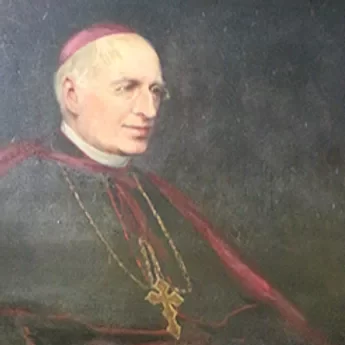
Bishop John Vertue
1882 – 1900
Bishop John Baptist Cahill
In 1900, due to the ill-health of Bishop Vertue, he was appointed as Auxiliary Bishop of Portsmouth. Bishop Francis Bourne, then Bishop of Southwark, consecrated him as Bishop Titular of Thagora in partibus infidelium on 1st May 1900, Bishops John Hedley (Newport & Menevia) and Charles Graham (Coadjutor of Plymouth) were co-consecrators. Three weeks later Bishop Vertue died, but it was not until three months later (in August 1900) that Bishop Cahill was confirmed as his successor.
Bishop Cahill oversaw the completion of the Cathedral’s construction, with the Narthex,West Porch, and turrets being completed in 1906. His tenure was marked by an influx of Religious Houses to the diocese (those fleeing from persecution in France). It was during his time that five Benedictine Abbeys were founded; Quarr, Farnborough, Ryde, and East Cowes from the Solesmes Congregation, and Douai of the English Benedictine Congregation.
Bishop Cahill died in Portsmouth, at the age of 68, on 2nd August 1910.
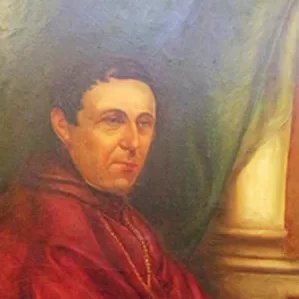
Bishop John Baptist Cahill
1900 – 1910
Bishop William Cotter
In 1905 he was appointed as Auxiliary Bishop of Portsmouth by Bishop Cahill, who consecrated him as Bishop Titular of Clazomenae in partibus infidelium at Portsmouth on 14th February 1905 with Bishops George Burton (Clifton) and Peter Amigo (Southwark) as co-consecrators. The Parishioners of Ryde gave him a gift of a carved oak episcopal throne, which is still used as the sedilia in St Mary’s Ryde today.
When Bishop Cahill died in 1910, it was once again William Cotter who succeeded him. He was enthroned as Bishop of Portsmouth on 24th November 1910. As diocesan Bishop, Cotter is well known for holding to a then-common practice of only accepting Irish-born candidates for the priesthood. It was for this reason that a local priest, who would go on to become Bishop of Portsmouth, Derek Worlock, was refused admission to the Seminary for Portsmouth and would instead study for Westminster.
Bishop Cotter governed the diocese for 30 years, and opened many new Churches. He added the St Patrick’s Chapel to Portsmouth Cathedral in 1924. When he died, the Lord Mayor of Portsmouth, Cllr Daly, paid him this tribute: “He was the embodiement of all that Christianity stands for. He always radiated kindness and that coupled with a sharp and genuine Irish wit made him a friend of all. To Catholics in his Diocese he was a father in the true sense of the word. He suffered ill health in recent years and this was borne nobly. If ever suffering was angelic it was with him. He would smile through pain.”
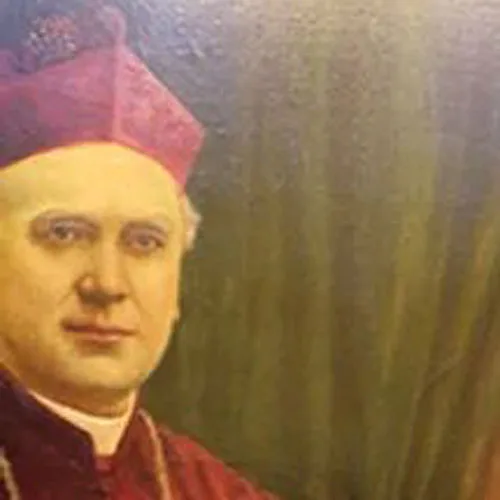
Bishop William Cotter
1910 – 1940
Bishop John Baptist Cahill
John Henry King was born in Wiltshire in 1880 and was ordained to the Priesthood in Jersey in 1904. In 1938 he was appointed as Auxiliary Bishop of Portsmouth. He was consecrated as Bishop Titular of Opus in Partibus infidelium on 28 May 1938. Bishop Cotter was the principal consecrator with Archbishop Peter Amigo (Southwark) and Bishop William Brown (Auxiliary of Southwark, Titular of Pella) as co-consecrators. He would be the last Auxiliary Bishop of Portsmouth.
Bishop King succeeded Bishop Cotter as Bishop of Portsmouth almost a year after Bishop Cotter’s death, on 4th June 1941. In 1958 he was granted the title of Archbishop ad personam. He is the only Bishop of Portsmouth to have been granted this title. In 1960, he consecrated Thomas Holland (originally of the Liverpool Archdiocese) as his Coadjutor Bishop. Normally a Coadjutor assists the Bishop in the government of the diocese and automatically succeeds him upon his death and retirement. In Archbishop King’s case this did not happen; Holland was unexpectedly appointed as Bishop of Salford in August 1964. King again governed the diocese alone from 1964 until his death in March 1965.
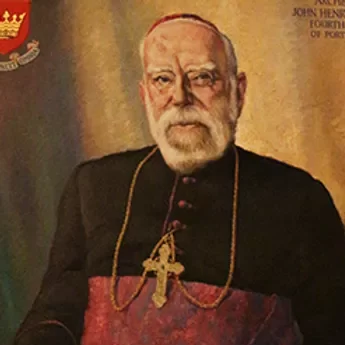
Archbishop John Henry King
1941 -1965
Bishop Derek Worlock
Derek Worlock was born in London in 1920. By the time he was of an age to enter the minor seminary his family home was in Winchester. Being from a family of Anglican converts, and (more importantly) not being Irish, he was refused admission for Portsmouth by Bishop Cotter. Instead, from 1934 he attended St Edmund’s College, Ware, as a student for the Archdiocese of Westminster. He was exempted from military service during the Second World War and rushed through the Seminary programme owing to the desire for priests to serve as army chaplains, and was ordained to the priesthood in June 1944 by Cardinal Bernard Griffin (the Archbishop of Westminster). He was appointed as Cardinal Griffin’s priest secretary, in which post he would serve successive Archbishops of Westminster for two decades. He attended every session of the Second Vatican Council from 1962-1965.
He was appointed as Bishop of Portsmouth on 18th October 1965, and consecrated by Cardinal Heenan on 21st December 1965. Bishop Worlock’s time in Portsmouth, the decade following the Second Vatican Council, was one of the more turbulent periods in the modern history of the Church. A large number of Churches in the diocese, among them the many Victorian Churches built immediately following Catholic emancipation (including the Cathedral) were changed to better reflect the spirit of the times. Thirty new Churches were built in the diocese during his tenure. Bishop Worlock focused in particular on improving Ecumenical relationships. He was appointed as Archbishop of Liverpool in 1976, after more than a decade in Portsmouth, becoming the first Bishop of Portsmouth not to die in office.
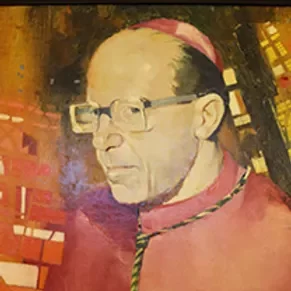
Bishop Derek Worlock
1965 – 1976
Bishop Anthony Joseph Emery
Bishop Emery was born in Staffordshire in 1918, and served in the Military during the Second World War (1940-1945). He studied for the priesthood at St Mary’s College Oscott and on 30 May 1953 he was ordained as a priest for the Archdiocese of Birmingham by Bishop Humphrey Bright (Titular of Soli, Auxiliary Bishop of Birmingham).
On 6 December 1967, he was appointed as Auxiliary Bishop of Birmingham (Titular Bishop of Tamallula). He was consecrated in St Chad’s Cathedral on 8 March 1968 by Archbishop George Dwyer (Birmingham) as principal consecrator with Bishops Joseph Rudderhorn (Clifton) and Joseph Cleary (Auxiliary of Birmingham) as co-consecrators.
He was translated to Portsmouth on 13 September 1976 and served as Bishop here for twelve years (until his death in 1988). He is buried in Milton cemetery in Portsmouth.
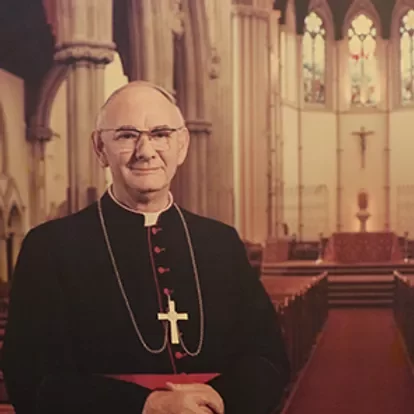
Bishop Anthony Joseph Emery
1976 – 1988
Bishop Crispian Hollis
Roger Francis Crispian Hollis (known by his middle name, Crispian) was born in Bristol in 1936. Both of his parents were converts to the Catholic Faith from the Church of England. His paternal grandfather George Hollis was the Anglican bishop of Taunton and his uncle Arthur Hollis was the Anglican bishop of Madras.
He attended Stonyhurst College, a Jesuit-run private school in Lancashire, before completing his national service as a Second Lieutenant in the Somerset Light Infantry Regiment. He was briefly deployed to Malaya. After national service he studied at Balliol College, Oxford. After Oxford, he was accepted as a Seminarian for the Diocese of Clifton, and studied at the Venerable English College in Rome. He was ordained as a priest in July 1965, and thereafter received a Licentiate in Sacred Theology (STL). In 1981 he was appointed as Vicar General for the Diocese of Clifton and Administrator (Dean) of Clifton Cathedral.
In 1987 he was appointed as Auxiliary Bishop of Birmingham to assist the Archbishop, Maurice Couve de Murville. He was consecrated as Titular Bishop of Cincari in St Chad’s Cathedral by the Archbishop, with Bishops Joseph Gray (Shrewsbury) and Mervyn Alexander (Clifton) as co-consecrators. Two years later he would be translated to Portsmouth, taking possession of the Diocese on 27th January 1989.
In 2011, at the age of 75, he tendered his resignation as Bishop to the Holy Father but remained as Apostolic Administrator of the Diocese until July 2012 when our current Bishop, Philip Egan, was consecrated as his successor. Bishop Crispian is the second Bishop of Portsmouth not to die in office, and has returned to live in his home diocese of Clifton. A special commemorative edition of the former diocesan magazine, Portsmouth People, was printed in honour of his retirement.
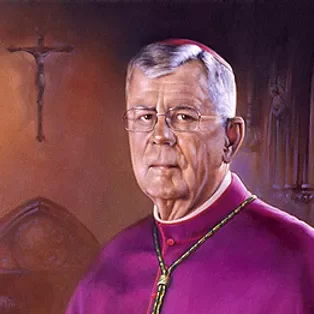
Bishop Crispian Hollis
1988 – 2012
